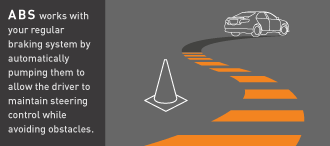Braking Systems
Antilock Braking Systems (ABS) detect the first signs of wheel lock under braking and interrupt the brake force for a fraction of a second at a time to allow the tyres to maintain grip. The main advantage of ABS is that it allows the driver to maintain steering control during wet braking, but it can also improve braking performance under low friction conditions (like a wet road) by allowing the braking force to remain at the maximum possible, just below the point at which a skid would start.

ABS is now widely specified on passenger cars (in the EU it is fitted to all cars, and in the USA it is standard on over 80% of cars and available as an option on the rest) and on Trucks.When ABS operates it’s important that the driver maintains pressure on the brake pedal and does not back off until the vehicle has slowed down as much as necessary.This US government website provides useful advice about using ABS:
> Learn more at NHTSA’s page on ABS
Emergency Brake AssistEmergency Brake Assist (EBA) also known as Brake Assist System (BAS) includes a range of electronic systems which detect a sudden application of the brakes in an emergency and automatically increase the brake force to the maximum allowed by the ABS.
View the Emergency Braking Assist Usage Graph
These systems mimic, or even improve on, the performance of an expert driver, by maximum braking faster than most drivers can do without assistance, and braking harder than many are able to do.
View the Braking Distances With and Without Brake Assist Graph
